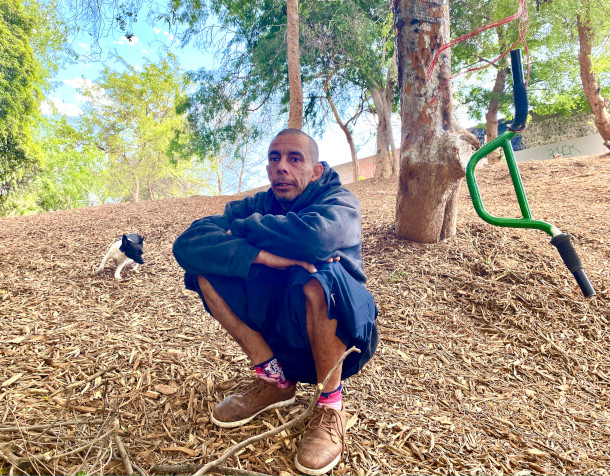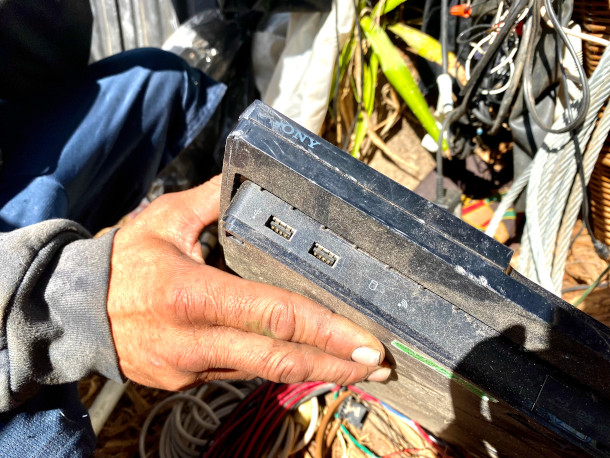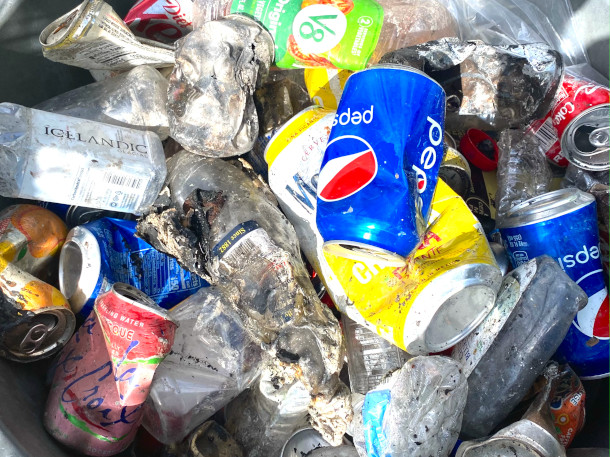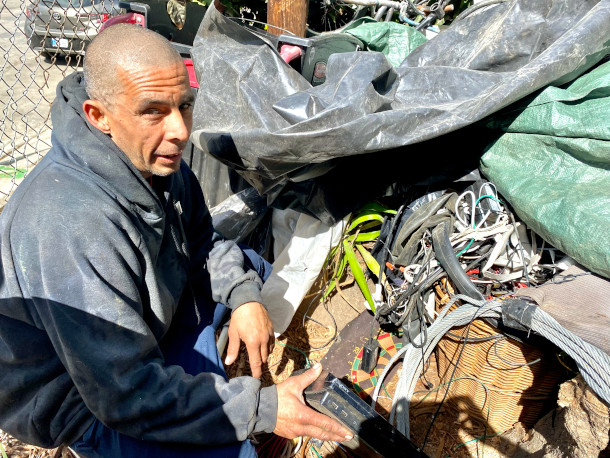Recycling and Unhoused Californians
Air Date: Week of February 10, 2023

Seen here with his dog, Timothy Tschappatt is an unhoused California resident who spends 12 hours a day finding recyclables and bringing them to recycling centers to earn money. (Photo: Isabella Zavarise)
The California recycling system depends heavily on the informal labor of unhoused residents who collect recyclables and bring them to recycling centers. But many unhoused people say the state has rarely engaged with them and can even make it more difficult for them to do their work. Reporter Isabella Zavarise digs into the story for Living on Earth.
Transcript
DOERING: California has one of the best recycling rates in the country. Consumers pay between 5 and 10 cents extra for most beverages with the expectation that the containers will be returned for the deposit and get recycled. But that system depends heavily on the informal labor of unhoused residents who scour the streets for recyclables and bring them to recycling centers. The workers make some money and keep the streets cleaner, a win- win. But many unhoused people say the state has rarely engaged with them and can even make it more difficult for them to do their work. Reporter Isabella Zavarise has been digging into the story for us.
[FREEWAY NOISE]
TSCHAPPATT: When we go through the trash it’s unlimited. The only thing I have not found is a submarine, a jet and a rocket.
ZAVARISE: Timothy Tschappatt, dressed in a basketball jersey, is a friendly, personable guy. His two small dogs run around him as he excitedly points to the tidy piles of items surrounding his home. He started collecting recyclables with his brother when he turned 16 for some money. He’s now 44, and has been unhoused for almost half his life. Tschappatt says his path to homelessness started when he was in prison. He lost everything, including family members who died during his 5-year sentence.
Now, he lives here, next to the 101 freeway, with his girlfriend. A few months ago, they woke up to Caltrans, the state’s transportation agency, rummaging through their encampment without warning. The agency tore through their belongings, not only leaving a mess for them to clean, but also taking recyclables they spent weeks collecting. Tschappatt says this isn’t the first time.
TSCHAPPATT: They mess our business up all the time. We are actually at least trying to get out of here, like straight up. We don't want to be here, to tell you the truth.
ZAVARISE: The Department of Transportation is supposed to provide 72 hours notice when they conduct these sweeps. Sometimes the couple has received these notices. Sometimes they haven’t. Michael Comeaux is a public information officer with Caltrans.
COMEAUX: The crew is not there to sort recyclables. The crew is there to remove trash and junk. The owners of any materials that are being stored along state highway right of way have that 72 hour period to remove anything that they want, and if material is left there, it's assumed to be trash.

Mr. Tschappatt says that Caltrans sometimes picks up collected recyclables from encampments without warning, mistakenly classifying the items as trash. This takes away potential income from Mr. Tschappatt and scavengers like him. (Photo: Isabella Zavarise)
ZAVARISE: Hearing that the items Tschappatt collects end up in the trash is a blow to him. Working 12-hour days rummaging through bins to earn a few hundred dollars is difficult and tedious work.
TSCHAPPATT: Oh, man, that makes my eyes so watery because I was like damn. Granted, that's money that we have found, but the time, effort, energy, everything, our youth. Everything is going down because of that, you know?
ZAVARISE: As of 2020, California’s homeless population was around 161,000 - the majority of which live in Los Angeles. Lack of support for Tschappatt, and the unhoused community more broadly, is a major flaw in California’s recycling system which depends on the informal labor of thousands of people. Unhoused people aren’t the only ones engaging in this work. Low-income families and gig-workers also help keep it going. The state’s recycling rate is around 70%, down from 75% in 2019; a number that keeps falling as recycling centers close.
Tri-CED community recycling is one of California's largest nonprofit recycling operations. Richard Valle is the president. He says the company pays anywhere from $17,000 to $22,000 in cash daily and sees up to 400 customers per day — most of whom are unhoused.
VALLE: People who take the time to stand in line and get cash for recyclables are not going to put it at the curbside because they want that return on investment. Therefore, the majority of the people who are in those lines need the cash. It supplements their income. It's just that simple.

The California recycling system relies heavily on the informal labor of scavengers like Timothy Tschappatt, who keep recyclables out of landfills. (Photo: Isabella Zavarise)
ZAVARISE: A bounty on bottles and cans drives recycling rates, but in L.A. County there are just under 400 recycling centers left. Many of these centers have closed in the last few years due to decreasing aluminum prices and high operating costs. Recently, Governor Gavin Newsom promised to invest $220 million dollars into recycling centers. These businesses are important because recycling centers are one of the few places that pay for recyclables and few grocery stores will take these items.
Recycling has become so difficult for some that last year, Tschappatt started a business to handle recycling for people who don’t know how to navigate the system. It’s called Recycling Junk Kings. He refurbishes items, declutters garages, and strips gold and copper out of discarded electronics. People also drop off items in front of his tent near the freeway to return to recycling centers. Tschappatt doesn’t own a car. He uses a luggage cart to push the recyclables up a steep hill until he gets to the closest center.
TSCHAPPATT: I deal with trash all day, every day. I only hold what I know has a value to it. It's free money. Why wouldn't you want to get it? People see us and they're like ‘Oh they’re homeless? Like damn we know how they are. They're going to pollute everything.’ As you can see, I keep it clean, as clean as I can.
ZAVARISE: There is no clear measurement of how much people that engage in the informal recycling economy prevent from winding up in landfills. One study from 2002 found that salvagers in Santa Barbara brought in nearly a third of the total weight of material being recycled. CalRecycle doesn’t track who redeems containers and if they have an address or not. They do know that most people bring in far more recycling than they could actually produce themselves, suggesting that they collected the bulk of the material. Despite all of the work unhoused people do to keep beverage containers out of landfills, they’ve never been included in the decision making process, says Scott Smithline, a previous director of CalRecycle.

Despite the role they play in the recycling system, unhoused people have rarely been included in the decision-making process. (Photo: Isabella Zavarise)
SMITHLINE: If I’m being honest, I just had like a little emotional experience where I realized that, you know, in my tenure at the department I didn't make any effort to reach out to the unhoused community. You know, we sort of applauded ourselves to try and bring our public meetings and to bring our recycling programs to as many diverse communities as possible. But if I'm being honest, I can't recall ever directly reaching out to the unhoused community representatives and asking them to join us in those conversations. I consider myself to be a fairly open minded guy. And the fact that I didn't even make that happen, probably tells you that there's a lot of work that needs to be done.
ZAVARISE: Smithline acknowledges the failures CalRecycle has made in engaging the unhoused community. And after years of struggling with the government, Timothy Tschappatt is skeptical of working with them.
TSCHAPPATT: Let me tell you the truth on that. Say we did do something like that. Like, they would never pay attention to those ideas. They would say they brought it up themselves. Plain and simple, they would not give the credit where credit is due period and the people would just keep struggling.
ZAVARISE: For now, California doesn’t have plans to include unhoused people in its recycling efforts. Though they might look to cities like Vancouver, Canada where local businesses hire people to sort their recyclables. It’s honest work that keeps waste out of the environment, helps recycling centers stay open and combats the stigma associated with informal trash collection.
For Living on Earth, I’m Isabella Zavarise in Los Angeles.
Links
California Department of Transportation
CalMatters | “California Accounts For 30% of the Nation’s Homeless, Feds Say”
Living on Earth wants to hear from you!
Living on Earth
62 Calef Highway, Suite 212
Lee, NH 03861
Telephone: 617-287-4121
E-mail: comments@loe.org
Newsletter [Click here]
Donate to Living on Earth!
Living on Earth is an independent media program and relies entirely on contributions from listeners and institutions supporting public service. Please donate now to preserve an independent environmental voice.
NewsletterLiving on Earth offers a weekly delivery of the show's rundown to your mailbox. Sign up for our newsletter today!
 Sailors For The Sea: Be the change you want to sea.
Sailors For The Sea: Be the change you want to sea.
 The Grantham Foundation for the Protection of the Environment: Committed to protecting and improving the health of the global environment.
The Grantham Foundation for the Protection of the Environment: Committed to protecting and improving the health of the global environment.
 Contribute to Living on Earth and receive, as our gift to you, an archival print of one of Mark Seth Lender's extraordinary wildlife photographs. Follow the link to see Mark's current collection of photographs.
Contribute to Living on Earth and receive, as our gift to you, an archival print of one of Mark Seth Lender's extraordinary wildlife photographs. Follow the link to see Mark's current collection of photographs.
 Buy a signed copy of Mark Seth Lender's book Smeagull the Seagull & support Living on Earth
Buy a signed copy of Mark Seth Lender's book Smeagull the Seagull & support Living on Earth

